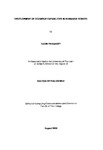Development of Cognitive Capabilities in Humanoid Robots
| dc.contributor.author | Tikhanoff, Vadim | |
| dc.contributor.other | School of Engineering, Computing and Mathematics | en_US |
| dc.date.accessioned | 2013-11-21T14:31:39Z | |
| dc.date.available | 2013-11-21T14:31:39Z | |
| dc.date.issued | 2009 | |
| dc.date.issued | 2009 | |
| dc.identifier | NOT AVAILABLE | en_US |
| dc.identifier.uri | http://hdl.handle.net/10026.1/2807 | |
| dc.description | Merged with duplicate record 10026.1/645 on 03.04.2017 by CS (TIS) | |
| dc.description.abstract |
Building intelligent systems with human level of competence is the ultimate grand challenge for science and technology in general, and especially for the computational intelligence community. Recent theories in autonomous cognitive systems have focused on the close integration (grounding) of communication with perception, categorisation and action. Cognitive systems are essential for integrated multi-platform systems that are capable of sensing and communicating. This thesis presents a cognitive system for a humanoid robot that integrates abilities such as object detection and recognition, which are merged with natural language understanding and refined motor controls. The work includes three studies; (1) the use of generic manipulation of objects using the NMFT algorithm, by successfully testing the extension of the NMFT to control robot behaviour; (2) a study of the development of a robotic simulator; (3) robotic simulation experiments showing that a humanoid robot is able to acquire complex behavioural, cognitive, and linguistic skills through individual and social learning. The robot is able to learn to handle and manipulate objects autonomously, to cooperate with human users, and to adapt its abilities to changes in internal and environmental conditions. The model and the experimental results reported in this thesis, emphasise the importance of embodied cognition, i.e. the humanoid robot's physical interaction between its body and the environment. | en_US |
| dc.language.iso | en | en_US |
| dc.publisher | University of Plymouth | en_US |
| dc.title | Development of Cognitive Capabilities in Humanoid Robots | en_US |
| dc.type | Thesis | |
| plymouth.version | Full version | en_US |
| dc.identifier.doi | http://dx.doi.org/10.24382/1465 |
Files in this item
This item appears in the following Collection(s)
-
01 Research Theses Main Collection
Research Theses Main


